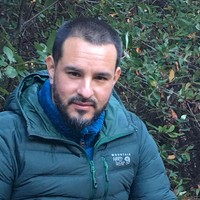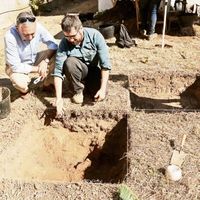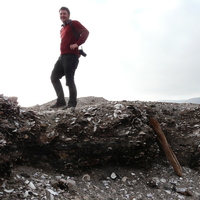
César Méndez
Pontificia Universidad Catolica de Chile, Estudios Aplicados, Antropología, Subdirector de Investigación
I am an archaeologist working on the early peopling of the southern cone of South America and human-environment interactions in semiarid regions of western South America: the subtropical Andes and Patagonia. Currently studying archaeological discontinuities in time and space in West Central Patagonia, its causes and consequences on the inhabited environments
less
Related Authors
Camilo Robles
The Australian National University
Pedro Andrade
Universidad de Concepción
Eugenio Aspillaga
Universidad de Chile
Steffen Pötsch
Universität Greifswald
Benjamín Ballester
Universidad de Tarapacá de Arica (UTA)
Patrick Faulkner
The University of Sydney
Philippe Béarez
Muséum National d'Histoire Naturelle
InterestsView All (69)






Uploads
Papers by César Méndez
few sites and occupations suggestive of low occupational redundancy as well as reduced archaeological assemblages, indicating limited activities in this landscape. However, several occupations date to the middle Holocene, a period when discontinuities in human occupations in response to adverse environmental conditions have been suggested on regional and supraregional scales. The main occupations detected at El Teniente are interpreted as a response to such conditions and in the context of changes in land use. Despite the spottiness of the archaeological record of El Teniente Bay, it is important in terms of its chronology and the differing trends in the use of space in comparison to other areas that have been the focuses of research. This paper addresses the archaeological record of El Teniente Bay and discusses its implications for human land use in the wider area of the coast of North-Central Chile.
the Andes has been interpreted as an indicator of discontinuity in human
occupations in response to adverse environmental conditions due to a
marked aridity. In the subtropical Andes of north-central Chile and
adjacent areas, this paucity has been detected in radiocarbon ages
between 8000 and 6000 cal BP. A systematic programme of cave
excavations with detailed chronologies in the Combarbalá area in the
Andean western foothills at 31°S allows questioning the role these
spaces and ecosystems played for hunter-gatherers throughout the
Holocene. The elusive record of dateable material has been addressed by
excavating deposits under rock-shelters which tend to trap sedimentary
material. This dataset has been compared with the available climate
records and shows a collation between the onset of various site
chronologies during the early-to-middle Holocene and periods of extreme
aridity. The organization of mobility and the role of Andean foothills for
hunter-gatherer settlements is reviewed. Resource availability in the
area, namely fresh water supply, good-quality toolstones, faunal
resources, and shelters, attracted mobile populations to these
environments as indicated by our records as well as others in the
broader region.
temporal distribution of this lithic material. Sampling was oriented to assemblages from deposits with radiocarbon-based time frames (10,700-300 cal BP). This paper presents geochemical (ICP-MS) analyses of 178 samples from 58 archaeological sites at 11 surveyed areas located along the Pacific coast, the Andean forest, and eastern steppe. Out of six potential sources, the Chaiten Volcano source (Los Lagos Region, Chile) dominates exclusively the occurrence of obsidians along the coastal fringe, while the Pampa del Asador source (PDA, Santa Cruz Province, Argentina) largely dominates (86% of samples) obsidian in the eastern steppe and the forest/steppe ecotone. This broad distribution is explained by the presence of the densely forested Andean mountain range acting as a biogeographical barrier. East of the Andes, we recorded an absolute dominance of PDA south of 45 30S, while more variability prevailed north of this point. The highest diversity of obsidians was recorded in the Cisnes River valley, probably because it is located closer to other alternative northern sources (Telsen/Sierra Negra, Sacanana and Angostura Blanca, all in Chubut Province, Argentina) and because it also hosts a local low-quality obsidian type. Based on this distribution, we discuss obsidian procurement behaviors by considering obsidian frequency and tool/debitage-class representation with increasing distance. We use the analysis of fall-off curves based on the distance of studied locations from the sources and include the use of leastcost paths for providing the most likely procurement routes. No obsidian diversification was recorded during the Holocene, hence the main driver for its procurement seems to be the distance from the source rather than the antiquity of its knowledge. Alternative procurement behaviors are discussed, specifically direct acquisition, exchange, and/or sporadic visits as mechanisms for explaining the archaeological patterns throughout the Holocene .
Subduction, isostatic rebound, and changes in global sea levels, combined with the last glaciation, have shaped the geography of the channels of Western Patagonia. Current archaeological research in this area includes some ten sites that allow us to characterize the occupation of this territory by marine hunter-gatherers. The studied archaeological sites also inform about the various geomorphological changes that the coastline has undergone. Archives dating back six thousand years ago and archaeological contexts yield new insights about the location, distribution, and position of the shoreline and its changes over time. We present a set of data, including new sites and AMS radiocarbon determinations, which supports the hypothesis that landforms have risen or subsided, and provide the bases for a working model in which archaeological ages can inform the chronology of changes in the region's coastal morphology. This paper suggest that human occupations between 6200 and 4400 cal BP recorded on high terraces of the Guiatecas Archipelago indicate higher local sea-levels, while the sites immediately on the waterfront are 2000 years younger. On the other hand, sites younger than 3300 cal BP on the modern coastline of the Chonos archipelago undergo permanent shaping, mainly due to local tectonics affecting vertical movement. Considering previously published and new data provided in this paper, we suggest preliminary uplift rates between 0.57 and 5.42 m/ka for the Guaitecas Archipelago, 0.31–1.48 m/ka for the northern sector of the Chonos Archipelago, and 0.85 m/ka in the central sector.
Please contact me if you are interested in this paper
Keywords: radiocarbon dates; climate change; human paleoecology; hunter-gatherers; mid-Holocene; Subtropical Andes.
In a recent paper in the journal Science (2014, Vol. 344, pp. 750-754), J. Chatters and colleagues present a new early human skeleton from the Yucatan, Mexico, considering it in the context of eight other early ‘Paleoamerican’ individuals—all from North America—that previously yielded ancient genetic evidence and/or direct radiocarbon ages. Despite including the archaeological site of Monte Verde II, Chile, in their discussion, we were alarmed that the authors otherwise ignored the South American record, presenting a map with the southern continent being devoid of PaleoAmerican human remains. We felt it important to remind our North American colleagues that South America has produced numerous directly dated human skeletal remains that are as old as the ones cited by Chatters and colleagues for North America, and that several of these have actually yielded mitochondrial (mt) DNA. Significant implications can be derived from this radiocarbon, bioanthropological, and mtDNA dataset, especially considering the antiquity of the earliest human populations and process of peopling of the New World.
few sites and occupations suggestive of low occupational redundancy as well as reduced archaeological assemblages, indicating limited activities in this landscape. However, several occupations date to the middle Holocene, a period when discontinuities in human occupations in response to adverse environmental conditions have been suggested on regional and supraregional scales. The main occupations detected at El Teniente are interpreted as a response to such conditions and in the context of changes in land use. Despite the spottiness of the archaeological record of El Teniente Bay, it is important in terms of its chronology and the differing trends in the use of space in comparison to other areas that have been the focuses of research. This paper addresses the archaeological record of El Teniente Bay and discusses its implications for human land use in the wider area of the coast of North-Central Chile.
the Andes has been interpreted as an indicator of discontinuity in human
occupations in response to adverse environmental conditions due to a
marked aridity. In the subtropical Andes of north-central Chile and
adjacent areas, this paucity has been detected in radiocarbon ages
between 8000 and 6000 cal BP. A systematic programme of cave
excavations with detailed chronologies in the Combarbalá area in the
Andean western foothills at 31°S allows questioning the role these
spaces and ecosystems played for hunter-gatherers throughout the
Holocene. The elusive record of dateable material has been addressed by
excavating deposits under rock-shelters which tend to trap sedimentary
material. This dataset has been compared with the available climate
records and shows a collation between the onset of various site
chronologies during the early-to-middle Holocene and periods of extreme
aridity. The organization of mobility and the role of Andean foothills for
hunter-gatherer settlements is reviewed. Resource availability in the
area, namely fresh water supply, good-quality toolstones, faunal
resources, and shelters, attracted mobile populations to these
environments as indicated by our records as well as others in the
broader region.
temporal distribution of this lithic material. Sampling was oriented to assemblages from deposits with radiocarbon-based time frames (10,700-300 cal BP). This paper presents geochemical (ICP-MS) analyses of 178 samples from 58 archaeological sites at 11 surveyed areas located along the Pacific coast, the Andean forest, and eastern steppe. Out of six potential sources, the Chaiten Volcano source (Los Lagos Region, Chile) dominates exclusively the occurrence of obsidians along the coastal fringe, while the Pampa del Asador source (PDA, Santa Cruz Province, Argentina) largely dominates (86% of samples) obsidian in the eastern steppe and the forest/steppe ecotone. This broad distribution is explained by the presence of the densely forested Andean mountain range acting as a biogeographical barrier. East of the Andes, we recorded an absolute dominance of PDA south of 45 30S, while more variability prevailed north of this point. The highest diversity of obsidians was recorded in the Cisnes River valley, probably because it is located closer to other alternative northern sources (Telsen/Sierra Negra, Sacanana and Angostura Blanca, all in Chubut Province, Argentina) and because it also hosts a local low-quality obsidian type. Based on this distribution, we discuss obsidian procurement behaviors by considering obsidian frequency and tool/debitage-class representation with increasing distance. We use the analysis of fall-off curves based on the distance of studied locations from the sources and include the use of leastcost paths for providing the most likely procurement routes. No obsidian diversification was recorded during the Holocene, hence the main driver for its procurement seems to be the distance from the source rather than the antiquity of its knowledge. Alternative procurement behaviors are discussed, specifically direct acquisition, exchange, and/or sporadic visits as mechanisms for explaining the archaeological patterns throughout the Holocene .
Subduction, isostatic rebound, and changes in global sea levels, combined with the last glaciation, have shaped the geography of the channels of Western Patagonia. Current archaeological research in this area includes some ten sites that allow us to characterize the occupation of this territory by marine hunter-gatherers. The studied archaeological sites also inform about the various geomorphological changes that the coastline has undergone. Archives dating back six thousand years ago and archaeological contexts yield new insights about the location, distribution, and position of the shoreline and its changes over time. We present a set of data, including new sites and AMS radiocarbon determinations, which supports the hypothesis that landforms have risen or subsided, and provide the bases for a working model in which archaeological ages can inform the chronology of changes in the region's coastal morphology. This paper suggest that human occupations between 6200 and 4400 cal BP recorded on high terraces of the Guiatecas Archipelago indicate higher local sea-levels, while the sites immediately on the waterfront are 2000 years younger. On the other hand, sites younger than 3300 cal BP on the modern coastline of the Chonos archipelago undergo permanent shaping, mainly due to local tectonics affecting vertical movement. Considering previously published and new data provided in this paper, we suggest preliminary uplift rates between 0.57 and 5.42 m/ka for the Guaitecas Archipelago, 0.31–1.48 m/ka for the northern sector of the Chonos Archipelago, and 0.85 m/ka in the central sector.
Please contact me if you are interested in this paper
Keywords: radiocarbon dates; climate change; human paleoecology; hunter-gatherers; mid-Holocene; Subtropical Andes.
In a recent paper in the journal Science (2014, Vol. 344, pp. 750-754), J. Chatters and colleagues present a new early human skeleton from the Yucatan, Mexico, considering it in the context of eight other early ‘Paleoamerican’ individuals—all from North America—that previously yielded ancient genetic evidence and/or direct radiocarbon ages. Despite including the archaeological site of Monte Verde II, Chile, in their discussion, we were alarmed that the authors otherwise ignored the South American record, presenting a map with the southern continent being devoid of PaleoAmerican human remains. We felt it important to remind our North American colleagues that South America has produced numerous directly dated human skeletal remains that are as old as the ones cited by Chatters and colleagues for North America, and that several of these have actually yielded mitochondrial (mt) DNA. Significant implications can be derived from this radiocarbon, bioanthropological, and mtDNA dataset, especially considering the antiquity of the earliest human populations and process of peopling of the New World.
Auditorio Edificio Sur
Facultad de Ciencias Sociales
Universidad de Chile
Av. Ignacio Carrera Pinto 1045, Ñuñoa, Santiago.
Programa:
Comentario libro: Comunidades Prehispanas de Chile Central. Organización social e ideología (0-1200 d.C.) a cargo de la Dra. Leonor Adán (Universidad Austral)
Comentario libro : Los Primeros Andinos. Tecnología lítica de los habitantes de Chile trece mil años atrás a cargo de la Dra. Fabiana Martin (Universidad de Magallanes)
http://www.aldiaconespanaychile.com/cesar-mendez-arqueologo_70/
Periodista richard García de El mercurio, el 30 de Octubre de 2014
Periodista Richard García, el lunes 27 de Octubre de 2014 en El Mercurio
Periodista Richard García, Martes 10 de Octubre de 2014 en El Mercurio
In the case of South America, and more than two decades after the paper by Rick (1987) was published, a special issue of Quaternary International (Bueno et al. 2013) renewed the discussion on the early peopling in light of chronological data from Late Pleistocene-early Holocene sites. Through compiling all the available dates earlier than 7000 BP, that volume offered a complete picture of the current debate on how and when humans reached the different parts of the continent, and also outlined the main interpretative issues and unresolved scientific questions for the archaeology of the region (Bueno et al. 2013). Somehow, the present volume of Quaternary International stands as a continuity of that previous issue. In this case, our focus turned to a narrower spatial scale of the Southern Cone, and the set of papers considered here report on a much broader chronological scale, including case studies in different time frames extending the Holocene period. The papers in question are the outcome of a Symposium held during the spring of 2012 at the XIX Congreso Nacional de Arqueología Chilena held in Arica (Chile) and cover a vast spatial scale, and a wider time frame. Several topics were discussed, among which we can highlight: the reliability of using 14C datasets for paleodemography, comparisons between 14C datasets and environmental trends, the use of thermoluminiscense datasets, and the effect of scientific and taphonomic biases on the regional archaeological signals. Since dates cannot be considered as a straightforward proxy for demography, our aim was to discuss the usefulness of compiling such data for assessing long-term regional trends in human dynamics. This volume offers data for discussing dispersal episodes and demographic models for the Southern Cone of South America, along with providing systematized radiocarbon datasets coupled with geographic information.
The volume consist of ten papers which represent most of the archaeological areas of the Southern Cone of South America: northern Chile (Gayó et al.), Central Chile and Central-West Argentina (Méndez et al.; Falabella et al.), Southern Chile (Campbell and Quiroz), Northeast of Argentina and Southeast of Brasil (Bonomo et al.), Pampas of Argentina (Berón; Martínez et al.), and Patagonia (Barberena et al.; Zubimendi et al.; García Guraieb et al.). A total of 3454 dates, from more than 1280 sites were compiled in the volume as a whole. Authors thoroughly selected dates at different spatial scales and mostly calibrated them with the latest available calibration curve for the Southern Hemisphere (Hogg et al. 2013) with updated calibration programs.
New research from throughout South America prompts a review of existing data and a synthesis of new advances. The SAA session aimed to gather current research on the spatial distribution and chronological associations of early lithic assemblages, regional raw material selection and procurement practices, differential representation of reduction sequences/stages at sites, possible relationships between bifacial assemblages and other designs, and the roles of early lithic technologies in subsistence and settlement patterns. Speakers from different countries gathered in order to shed light on regional variability and to illustrate different methodological approaches. Each participant or group of participants presented their up-to-date syntheses of regional lithic technological research problems and ways in which they have worked to solve them.
The second major achievement was to collect the symposium contributions into this Chungara issue. In order to encourage greater interaction, papers have been written in English and Spanish, in order to promote dialogue among those working on lithic technological problems in South America, North America, and elsewhere. We acknowledge the commentaries of the two symposium discussants, Nora Franco and David Anderson, who have kindly agreed to contribute to this number.
The original impetus for the SAA session and this number has been creating venues for sharing current developments and thinking on the early peopling of South America. Gathering together researchers from a wide variety of places, disciplinary traditions, and experiences has been motivated by the idea of listening to each other and writing down our results. After all, those of us working on the early settlement of America are united by one of the colonized places on earth.
Amante de su Universidad, la casa de estudios y el club deportivo, nunca dejó de tener a <<La Chile>> en su corazón. El vació que deja no sólo es emocional e intelectual, sino que tangible, pues nadie se atreve a dejar de decirle <<el laboratorio de Donald>>, al que fuera su espacio ganado en el Departamento de Antropología. La placa grabada con su nombre afuera de éste es sólo un recuerdo tangible de su presencia en nuestra Universidad.
Muchas serán las historias que nos acordaremos a lo largo del tiempo; como su acercamiento inicial a la arqueología cuando como adolescente participó de los trabajos de Lautaro Núñez en Quereo; o cómo cambió mil veces la historia de cuando perdió una de las falanges de su mano. Recordaremos sin dudas su participación en los Congresos Nacionales y como siempre tuvo tiempo, ganas y disposición para conversar con profesores y alumnos por igual, frente a un problema arqueológico desafiante.
Como formador nunca se desvió de la noción que la enseñanza universitaria debía transmitir la experiencia de investigación, y así organizaba sus clases en función de los problemas que consideraba relevantes. La transmisión de una enseñanza comprometida es la que influyó en muchos de sus alumnos no sólo en la elección de temas, sino que en la orientación de cómo hacerles frente.
Tuvo gran compromiso social, y fue crítico con la arqueología actual y especialmente con la mercantilización de nuestra profesión. Ese rol crítico fue el que inspiró a Donald a enseñar con su ejemplo cómo una arqueología debía ser comprometida a nivel regional, donde la producción de conocimiento publicado era la única vía de concluir el proceso de investigación.
Sin embargo, lo que probablemente resulta más difícil es poder sintetizar su contribución como arqueólogo e investigador. Más allá de la enorme cantidad de artículos publicados de la que fue autor, quisiera comentar que en el proceso de escribirlos, él siempre pensó en apuntar más alto. Continuamente buscó las implicancias globales de aquello que investigaba y, como le gustaba expresar, no había nada más relevante que la arqueología de Los Vilos. Su vocación genuina era entender que lo que hacía, era realmente lo más significativo. Infundió ese espíritu en todos los que estuvieron a su alrededor. Esta disposición además fue generosa a un nivel superlativo, pues habría que considerar la gran cantidad de coautorías que tuvo con sus estudiantes a lo largo de carrera. No es la oportunidad para definir cuál o cuáles trabajos constituirán su contribución más relevante, cada uno de nosotros fue tocado en alguna dimensión de su productividad y como tal, habrá mucho desde donde elegir.
Algunas aproximaciones muy discutidas en la actualidad, como la interdisciplinariedad, para él nunca fueron tema, sino que el enfoque esperado. No se podía alcanzar el conocimiento humano sino a través de una óptica que considerase, desde sus preguntas, el abordaje de múltiples fuentes de conocimiento, con sus alcances y limitantes. Probablemente una de las cosas que más lo llenaba de orgullo era el pensar deductivamente y que los problemas precedieran los hallazgos arqueológicos. Crítico y autocrítico, Donald Jackson, siempre estuvo en la frontera del conocimiento en arqueología y es impresionante como poseía un espíritu incluso más abierto que el de muchos de los más jóvenes, promoviendo temas novedosos que sólo recién empezamos a visualizar como relevantes.
También Donald Jackson representa a un estirpe de arqueólogos poco replicable, ya que investigó no sólo en el entorno de sus amores, Los Vilos, sino que en México, Radal Siete Tazas, Tierra del Fuego, el Desierto de Atacama, Cuchipuy, y tuvo una opinión crítica del trabajo en otras partes. Entre sus contribuciones transversales más relevantes estuvo haber instaurado una forma sistemática de analizar los conjuntos líticos en Chile, una que integró el valor de lo funcional, la tafonomía, las cadenas operativas y gestos técnicos y las interpretaciones vinculadas a la organización espacial de las poblaciones de cazadores recolectores. Amante de la costa siempre estuvo interesado por las trayectorias humanas en los ambientes litorales, con especial interés en que tan antiguas fueron estas adaptaciones. De ese modo, se volvió un referente para el poblamiento temprano en la arqueología nacional. Más allá de sus trabajos en Los Vilos, Donald Jackson se destacó por su contribución a la interpretación de la ocupación temprana de Tierra del Fuego y Patagonia continental. En sus últimos años, este interés lo llevo ampliar sus horizontes geográficos con colaboraciones en el Norte de Chile, y también a través de contribuciones críticas a nivel sudamericano. Como tal era representante de Chile en la red Orígenes organizada por el Institut Català de Paleoecologia Humana i Evolució Social.
Quizás una de sus proezas más destacable es haber podido completar la escritura de su tesis doctoral estando ya enfermo. Prueba de esfuerzo y de su tenacidad, uno de los atributos que más valoraba, Donald entregó el manuscrito finalizado de su obra: “El Primer Poblamiento de la Costa Pacífica Sudamericana: El Complejo Huentelauquén”. Esto no sólo representa un ejemplo de su amor por la profesión, sino una enseñanza de actitud frente a la vida para todos los que tuvimos el honor de conocerlo.
Amigo de sus amigos, maestro para sus estudiantes, crítico arqueólogo para sus colegas; me siento honrado de haber podido ser los tres.